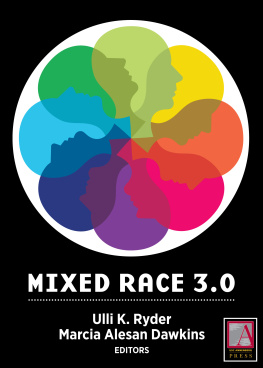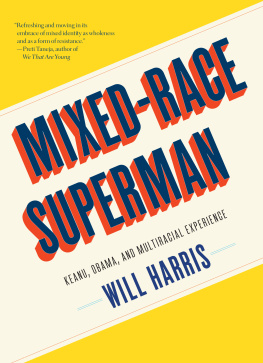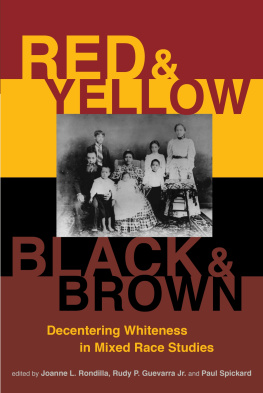La Nature aime les croisements (Nature loves cross-breedings).
~Ralph Waldo Emerson quoting Charles Fourier
On a dank evening in London in 1617, the audience was distracted from a performance of Ben Johnsons The Vision of Delight by the persons sitting next to King James I and Queen Anne: a dashing adventurer who had just returned from the outer edge of the fledgling English empire and his new young spouse. The kings guests were John Rolfe and his wife Rebeccaa name newly invented to Anglicize Pocahontas, the daughter of Powhatan. The first recorded interracial marriage in American history had taken place because Rebeccas father and the English leaders in the colony of Virginia were eager to forge a detente after a decade of abrasive and bloody European-Algonkian contact on the shores of the Chesapeake Bay.
The Rolfe-Pocahontas marriage might have become the embryo of a mestizo United States. King James was not concerned about interracial marriage. He fretted only about whether a commoner such as Rolfe was entitled to wed the daughter of a king. Nearly a century later, Robert Beverleys History and Present State of Virginia described Indian women as generally beautiful, possessing uncommon delicacy of shape and features (Beverly, 1705/1947, p. 159, see also pp. 3839). He regretted that Rolfes intermarriage was not followed by many more. William Byrd, writing at the same time, commended what he called the modern policy of racial intermarriage employed in French Canada and Louisiana, by which alliances (rather than warfare) were effected. Byrd was sure that English false delicacy blocked a prudent alliance that might have saved Virginians much tragedy. Most colonies saw no reason to ban intermarriage with Native Americans (Byrd, 1841/1929, pp. 34).
In 1784, Patrick Henry nearly pushed through the Virginia legislature a law offering bounties for white-Indian marriages and free public education for interracial children. In the third year of his presidency, Thomas Jefferson pleaded to let our settlements and theirs [Indians] meet and blend together, to intermix, and become one people. Six years later, Jefferson promised a group of western Indian chiefs, you will unite yourselves with us... and we shall all be Americans; you will mix with us by marriage, your blood will run in our veins, and will spread with us over this great island (Jefferson, 1808/1908, p. 190).
In 1809, almost 200 years after Pocahontas sat in the theater with James I, 16-year-old Sam Houston made his way west from Virginia to Hiwassee Island in western Tennessee. He took up life among the Cherokees and was soon adopted by Ooleteka, soon to become the Cherokee chief. Reappearing in white society in 1818, Houston launched a tumultuous, alcohol-laced, violent, and roller-coaster political career, but he retained his yen for the Cherokee life. After his disastrous first marriage at the age of 36, he rejoined the Cherokee, became the ambassador of the Cherokee nation to Washington (in which office he wore Indian regalia) in 1829, and married Ooletekas niece, the widowed, mixed-blood Cherokee woman Tiana Rogers Gentry.
His drunken arrogance soon led to Houstons exile from the Cherokee nation. Leaving his Cherokee wife, he headed for Texas to fight and speculate his way to fame. In 1836, as president of the Republic of Texas, Houston hoped to cement an alliance between Cherokees and whites that would combine Texas and northern Mexico into a vast territory with plenty of land both for a new Cherokee homeland and for Anglo-Texan settlers.
In both Virginia and Texas, prejudice and violence blocked the way toward what might have become a mixed-race American republic. Pocahontas died after boarding a ship in England in 1617bound for Virginiawith Rolfe and their infant son. With his mixed-race son, Rolfe reached Virginia, married again in 1620, and died two years later in an all-out assault mounted by the half-brother of Pocahontas father. Intermarriage in Virginia thereafter was a rarity.
Two centuries later, after Houston worked to protect the Cherokees from white settler racism and violence in Texas, his successor as president of the Republic of Texas, Mirabeau Buonaparte Lamar, called for a policy of Cherokee expulsion or extinction. In 1839, when the Texas army attacked the defiant Cherokees, Houstons old friend Chief Bowles died holding a sword inscribed by Houston.
Other forerunners of a mestizo nation were more successful. English, French, and Spanish fur traders in North America, from the early 1600s to the late 1800s, were typically married to Indian women. They became the very symbol of mestizo Americametissage is the French term (comparable to the Spanish mestizaje) for the joining of English or French traders and their Indian wives, and their offspring were metis. Irish trader John Johnson could hardly have done business in Indian villages without his Ojibway wife. Nor could Michael Laframboise, a French immigrant, whose Okanogay wife paved the way for his trading with the Indians in Oregon Territory. Laframboise boasted about having a high-ranking wife in every Indian tribe inhabiting the region he worked as a trapper. The fabled Jim Bridger married three times, each time to an Indian woman, once to the daughter of Chief Washakie of the Shoshone. Equally fabled Kit Carson had four wives: an Arapaho, a Cheyenne, a Mexican, and a Taos-born Indian-Mexican woman.
The fur traders, trappers, and trail blazers tell us of a frontier that should be conceptualized as a zone of deep intercultural contacts, rather than as a line that divided two societies, one advanced and the other primitive. The frontier, as it involved white settlers and native peoples, is indelibly etched in our national consciousness as a battleground, but it was also a cultural merging ground and a marrying ground. Nobody left the frontier cultural encounters unchanged.
Two further examples of mestizaje, one from the 19th century and one from the 20th, illustrate the in-betweenness of many who confounded the official racial taxonomy of the United States. The first example is the mixing of American Indians and African Americans. In every part of eastern North America from the 1600s to the 1800s, escaping African slaves sought refuge among Native Americans, relying on a natural affinity between oppressed peoples. Despite white attempts to block such intermingling, the blood lines of Cherokees and Mandingo, Creeks and Fula, Choctaws and Ashanti became mixed as fugitive slaves disappeared into Indian society. The Africans took Indian spouses, produced children of mixed blood, and contributed to Afro-Indian transculturation.
The revolutionary era was neatly bracketed by two Afro-Indians. The first bloodshed in the Boston Massacre of 1774 was that of Crispus Attucks, whose father was black and whose mother was Indian. In the aftermath of the Revolution, it was Paul Cuffe, son of an African father and a Wampanoag mother, who planned the repatriation of black Yankees to Sierra Leone after concluding that it was nearly impossible for black New Englanders to find a life of liberty and happiness in the new republic.
Up and down the seaboard, Indian-African intermixing continued. The whaling boat crews of Nantucket Island had many African-Indians, including the harpooners celebrated by Herman Melville. On the peninsula comprising Delaware, eastern Maryland, and eastern Virginia, deep-rooted mixtures of red, white, and black peoples created triracial communities. Still today, from Alabama to New York, the Lumbees, Red Bones, Wesorts, Brass Ankles, and many other tri-racial societies maintain their distinctive identities.
A second example of mestizaje occurred in Californias San Joaquin and Imperial valleys. In the early 20th century, large landowners could no longer find new Chinese and Japanese contract laborers because of immigration restrictions. The cotton, fruit, and vegetable growers turned elsewhereto the nearly 7,000 Sikh immigrants from the Punjab. Arriving as single men or married men who could not bring their wives and children, the Punjabis faced the creeping glacier of anti
Next page




